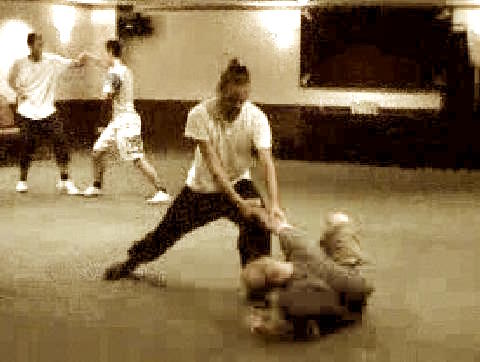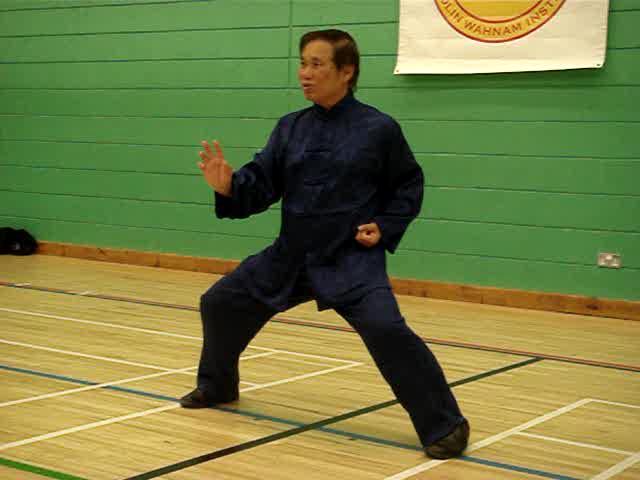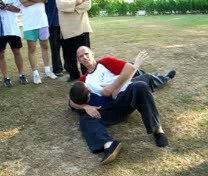INTENSIVE COURSES AND SPECIAL COURSES

Students practicing combat application during an Intensive Shaolin Kungfu Course
This article will help students answer many questions concerning intensive courses and special courses.
Let us compare as an example the Intensive Shaolin Kungfu Course to be held from 9th to 15th April in Penang and the Special Shaolin-Taijiquan Course to be held from 12th to 18th October in Sabah. The same principles apply to Taijiquan and chi kung courses.
The original aim of the Intensive Shaolin Kungfu Course was to train practitioners to be competent instructors. Skill development and combat application are the two pillars of any good kungfu training, but at the time I offered the first Intensive Shaolin Kungfu Course about 10 years ago, most kungfu students all over the world had little kungfu skills and could not apply their kungfu for sparring. A main reason for this deplorable situation was that most kungfu instructors themselves did not have these abilities. The course was meant to fulfil this need.
But over the years as more and more of our own Shaolin Wahnam students take this course, the main aim has shifted its emphasis from training instructors to providing a comprehensive course for fundamental kungfu training. These two aims are actually similar: any competent instructor must of course be well versed in fundamental kungfu training. The Intensive Shaolin Kungfu Course, Intensive Taijiquan Course and Intensive Chi Kung Course remain as a requirement for becoming a Shaolin, Taijiquan and chi kung instructor respectively of our school.
The Shaolin Kungfu Course is a fantastic course, covering all important aspects of Shaolin training, including stances, footwork, basic patterns, combat skills, internal force, combat sequences, combat application in all the four categories of striking, kicking, felling and chin-na, counters against other martial arts, tactics, strategies and kungfu philosophy. Our distracters may be angry at what I am going to say, but it is true that a student learns more in five days in this course than many other kungfu practitioners learn in many years.

Grandmaster Wong demonstrates how to develop internal force in the Triple-Stretch Set during a regional special course
It was not too long ago when many people wondered why we in Shaolin Wahnam did not practice classical sets. (Now they may wonder why we practice so many classical sets!) The reason was to meet expedient needs. Classical sets represent the crystallization of the best techniques, tactics and strategies of past masters, though many students performing these sets today may not know them. These techniques, tactics and strategies are too sophisticated for beginners. If you begin with classical sets, you would not be able to use their sophisticated patterns effectively for combat. At best you would perform these classical sets for demonstration, and resort to boxing and kick-boxing when sparring.
To help you overcome this problem I selected relatively simple techniques and tactics, and linked them into combat sequences for you to train combat application. This method is very cost-effective. Not only you become combat efficient in a short time (in a much shorter time than I myself took), you are also comprehensive in your combat ability, being able to handle all categories of attack (an ability not many martial artists may have).
Having trained in this fundamental stage, you can then move to the next level, that of thinking and acting as a master. What better way to achieve this aim than learning the best techniques, tactics, strategies, skills and philosophy of past masters as recorded in their classical sets?
If you want to emulate Hoong Hei Koon, you learn his typical set, the Triple-Stretch. If you want to emulate Yang Lu Chan, you learn Flowing Water Floating Clouds, which approximates the type of Chen Style Taijiquan he practiced. If you want to emulate Wang Lang, you learn Eighteen-Collection, which Wang Lang composed from the best eighteen kungfu features he had gathered. If you want to emulate Ng Mui, you learn the Flower Set. If you want to emulate Zhang San Feng, you learn Wudang Taijiquan. This is where the Special Shaolin-Taijiquan Course comes in.
Actually you get more. Besides deepening your understanding and performance of your chosen set, you also collectively learn about all the other special sets at the course. You learn about different ways of developing internal force, as well as different ways of overcoming similar combat situations. You would, for example, be able to look at any set, including those you have not seen before, and show a scope and depth of understanding that even those who have practiced the set for years would be amazed. While all the combat sequences have been prepared for you at the Intensive Shaolin Kungfu Course, at the Special Shaolin-Taijiquan Course you have to compose your own combat sequences and justify your composition with good kungfu philosopjhy.
It would be helpful to briefly explain the use of the term "special". We have used this term "special" to mean that it is not ordinary or not common to all students. If I teach a course on 16 Shaolin combat sequences, or 12 Taijiquan combat sequences, or generating energy flow, I would not use the term "special" because the instructional material is common to all Shaolin, Taijiquan and chi kung students. But if I teach a course on Wuzuquan, or Cloud Hands, or Small Universe, I may use the term "special" because not all Shaolin, Taijiquan or chi kung students will learn it.
There are two distinct levels of special courses - at a regional and introductory level, and at a centralized and master level. The Wing Choon course taught on the Blue Mountain from 3rd to 7th March 2011 was at a regional, introductory level, whereas the Wing Choon course taught in Penang from 29th April to 5th May 2010 was at a centralized, master level. The Tantui, Eagle Claw, Triple-Stretch, Iron-Wire, Flower Set, Asking Bridge courses taught at various places were at an introductory level. If you wish to deepen any of these sets, you can do so at the Special Shaolin-Taijiquan Course.
Saying the special regional are introductory is using the term as it really means as well as in comparison with the master-level centralized courses. By themselves these regional courses are quite advanced. The introduction to the various arts is both comprehensive and in-depth. Again, distracters may be angry at what we say, but it is true that students at these introductory courses learn in a few days what many other people may not learn in many years. Practicing Siu Lin Tou to develop internal force which students at the introductory Wing Choon course learned, for example, is a secretive art normally reserved for top disciples, and countering an attack like "Reverse Riding of Donkey" is not what many martial artists know.

Sifu Kai Uwe demonstrating a Judo lock during a centralized special course
